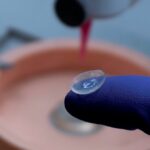

Degenerative joint diseases like arthritis affect millions of people around the world, and range in severity from somewhat annoying to severely debilitating. While scientists have been trying for decades to create cartilage in the lab, it’s proved to be difficult, especially when it comes to the complex, load-bearing cartilage in the knee. So it’s quite a breakthrough that Indian researchers have managed to develop cartilage that is molecularly similar to that in the knee, using 3D bioprinting.
The research team, led by Professor Sourabh Ghosh from the Department of Textile Technology at the Indian Institute of Technology (IIT) Delhi, 3D printed the cartilage using a bioink made up of silk proteins along with cartilage stem cells derived from bone marrow. The chemical composition of the bioink supports both cell growth and long-term cell survival, and has remained physically stable for up to six weeks. The research was published in a study entitled “Elucidating role of silk-gelatin bioink to recapitulate articular cartilage differentiation in 3D bioprinted constructs,” which you can access here.
“This is the first study from India where any 3D bioprinted tissue has been developed in a lab,” said Shikha Chawla, first author of the paper.
“The silk protein has different amino acids that closely resemble the amino acids present in human tissues,” said Ghosh. “Just like cells are surrounded by proteins inside our body, the cells in the engineered cartilage are also surrounded by bioink that has a similar composition.”
The sponge-like, load-bearing cartilage in the knee is called articular cartilage. So far, most cartilage produced in labs has been transient cartilage, which turns into bone cells and becomes brittle, losing its load-bearing abilities. Through bioprinting, however, the bone marrow-derived stem cells in the bioink gradually convert to chondrocyte-like cells, which are specialized cells that produce and maintain the extracellular matrix of cartilage.

“We have succeeded in stopping this conversion of chondrocyte-like cells or stem cells into bone cells so that they remain as stable articular cartilage,” said Ghosh.
The research team was able to do this by optimizing the composition of the bioink as well as the 3D bioprinting process, and by using a combination of growth factors. The silk/gelatin bioink was optimized in a way that activated two signaling pathways that are responsible for minimizing or stopping the conversion of cartilage into bone-like tissue.
“All earlier work never evaluated for the production of articular or permanent cartilage, while we assessed and found that our strategy leads to the production of permanent cartilage in the lab,” said Professor Amitabha Bandyopadhyay of the Department of Biological Sciences and Bioengineering at IIT Kanpur.
The cartilage cells retained their stem cell-like nature even after months of being cultured in the lab. This study is the most recent in a series of promising developments into 3D printed knee cartilage, including that of an Australian team which used a direct writing method to implant new cartilage into sheep.
“As a next step, we would implant this 3D bioprinted cartilage into the knee joints of animals to see if it remains stable in the knee joint and is able to integrate with the surrounding cartilage tissue,” said Ghosh.
The 3D printed cartilage may also prove valuable in in vitro drug delivery and pharmaceutical studies. Authors of the paper include Shikha Chawla, Aditi Kumar, Prasad Admane, Amitabha Bandyopadhyay, and Sourabh Ghosh. Discuss in the 3D Printed Cartilage forum at 3DPB.com.
[Source: The Hindu]
When it comes to 3D real estate visualization in the USA, our service provides the perfect solution for bringing property listings to life. Through our platform, you can easily access cutting-edge 3D renderings that showcase your real estate projects in a way that attracts potential buyers and investors. Whether it's residential, commercial, or mixed-use properties, our team of experts uses advanced technology to create immersive visualizations that highlight the best features of your property, making it easier for clients to imagine the space as their own.
Through our website, you can quickly get high-quality 3D real estate visualizations that are tailored to your specific needs. With our help, you'll stand out in the competitive real estate market by offering potential buyers a realistic, interactive view of your property. Our efficient process ensures a fast turnaround time, while our attention to detail guarantees that every aspect of the property is represented accurately, giving you a powerful marketing tool to promote your real estate listings.






